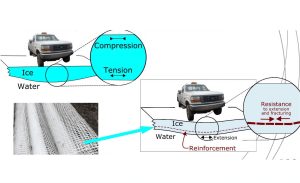The winter is here! In January and February, when the cold finally was here, many considered making ice roads to reach logging sites that are unreachable most other winters. But as many don´t know exactly how to do it and for how long the cold weather will stay, they hesitated.
This is an article signed Armas Jäppinen, editor at the sister site www.iskogen.se , translated by Per Jonsson.
Photo: Arisa Chattasa
Ice road truckers
In North Sweden there are some ice roads that replace ferry lines where and when the climate allows it. Those roads are however in most cases only for vehicles up to 2 tons.
As for heavier transports, the requirements on the ice roads are rather high. However, there is not much research available on the subject, at least not in Sweden. In Canada and Siberia, ice roads are absolutely crucial for the supply of goods and fuel to villages and mines. Here, the trucks actually can take more goods than the boats that are used when the waters are open. Considering the values of the goods transported in Canada, there should be something to learn from them?
In Canada research is going on to handle climate change better, above all at NRC, National Research Council Canada. When calling them, it turned out that Sweden has been pioneers when it comes to ice road research. Dr. Paul Barrette at NRC tells us that there were Swedish experts involved when the ice road nets of Canada were built. Paul also talks about a promising project at NRC right now, that looks into reinforcing the ice at weak points with modern geonets and/or steel wires.
The left photo shows reinforced ice, and the right without reinforcement.
Photos: National Research Council Canada.
In Sweden the road authorities are building ice roads on some locations in the north. Last winter, it was however reported that they are considering quitting that on some larger lakes. Earlier ice roads were built also in the south but not even this cold winter that has been done. They make sure to keep the ferry routes open instead.
In forestry there are ice roads built and used in north Sweden. When media mention these roads, it´s mainly when something has failed rather than when it was successful. Also on compressed mire roads, accidents have occurred when the ice have broken.
How difficult could it be – this isn´t rocket science is it?
Lots and lots of reinforced concrete is used today. The first patent concerning reinforced concrete is dated 1855. Apart from that, not only within forestry, we use miles and miles of non-woven fabric and geonet every day for road building. When asking the Swedish Traffic Agency if there is any research on ice road building going on, you are redirected to Lennart Fransson. A skilled but since many years back retired researcher at Luleå Technical University, LTU. Lennart willingly shares some solid tips over e-mail:
“Normally 90 cm (35”) ice is enough for timber transports on 7 axels and 60 tons total weight. At extremely low temperatures (below – 25 centigrade/-13 Fahrenheit) it is inappropriate to use the ice road as it will crack.” – Lennart Fransson
Lennart also sends over the “Handbook of ice” from 1995. An excellent publication for its time that among other things describes how to reinforce the ice by putting planks in a grid pattern. Lennart emphasizes that reinforcing very time consuming.
Photo: National Research Council Canada
Moving the water up on the surface
To get my thoughts and theories confirmed Dr. Paul Barrette was contacted again. A simple case that I could relate to and that should be suitable for a trial. A 200 meters long ice road over a lake:
- Yes, it´s most relevant to compare with reinforced concrete.
- Yes, it would be a benefit to place the reinforcement under/ at the bottom of the ice as this is where the load will be. If the ice continues to grow downward, you can make some notches with a chainsaw and pull a new geonet under the ice the same way you do with fishing nets.
- Yes, the ice will later thaw from below, but in a freshwater lake with no currents it mainly thaws from above.
- Yes, it could be a benefit with a white glass fiber net, mainly because it´s light, ductile and easier to pull under the ice. A white net doesn´t attract sun beams so much, but preferably there should be a lot of ice above to cover it for the sun.
- Yes, the net does good even if the geonet is only five meters wide. The ice cracks with or without reinforcement but not as easy with it.
- Yes, it´s correct that there are no scientific figures to determine how much stronger the ice road will be with reinforcement.

Illustration: National Research Council Canada and “White geonet”.
Finally, Paul hints about not thinking too much. Just do it, but be careful. It will be much better with reinforcement, and it will not be very difficult or expensive. But we still want to know how much better it will be if you succeed. So now we are thinking about how to design a full-scale trial with a 20-ton vehicle? Paul promises to keep researching with new trials in Canada. We promise to keep him informed about what happens here in Sweden.
Facts about ice roads
Ice roads were used not so long ago in large scale to transport ore, iron and timber in Sweden. In mid Sweden, in “Bergslagen”, there was a classic transport route that led over a long row of lakes. Before the railroads took over, this route was used for ice roads and floating.
Despite the climate change there are many ice roads built in the World every year. In Canada alone, over 8000 kilometers (4971 miles) according to NRC. Wikipedia seems to be updated on ice roads around the Baltic Sea and in the World. Apart from pure ice roads, there is a need in Swedish forestry to pass over mires. In the winter this could be done by improving the buoyancy by compressing moss and snow to make it freeze from above.














